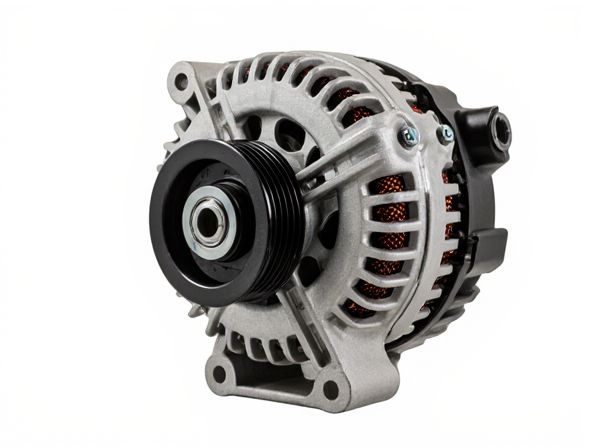
Photo illustration: Stator Slot-Filled vs Stator Skewed Design
Stator slot-filled designs maximize magnetic flux density by fully filling the slots with winding, enhancing torque production and efficiency in electric motors. Stator skewed designs reduce torque ripple and noise by slightly angling the slots or windings, improving smoothness and operational lifespan. Your choice depends on whether you prioritize peak performance or quieter, smoother motor operation.
Table of Comparison
| Feature | Stator Slot-Filled Design | Stator Skewed Design |
|---|---|---|
| Magnetic Efficiency | High, due to maximum slot fill with copper windings | Moderate, slight reduction from skewing |
| Cogging Torque | Higher cogging torque, causing rougher operation | Significantly reduced cogging torque, smoother rotation |
| Noise & Vibration | Increased noise and vibration levels | Lower noise and vibration, improved NVH (Noise, Vibration, Harshness) |
| Manufacturing Complexity | Simpler design, easier to manufacture | More complex manufacturing process, higher cost |
| Output Stability | Stable output with potential torque ripple | Enhanced output quality, reduced torque ripple |
| Thermal Performance | Good heat dissipation due to dense copper filling | Similar thermal performance, slight variation |
Introduction to Stator Designs
Stator slot-filled designs maximize electromagnetic torque by densely packing conductors within the stator slots, enhancing magnetic flux interaction and overall efficiency. Stator skewed designs reduce cogging torque and vibration through angled or twisted slots, improving smoothness and acoustic performance in electric motors. Both designs play critical roles in optimizing motor performance based on application-specific requirements such as noise sensitivity and power density.
What is a Slot-Filled Stator?
A slot-filled stator features winding coils densely packed inside the stator slots, maximizing the conductor cross-sectional area for improved electromagnetic efficiency and reduced copper loss. This design enhances the motor's magnetic flux distribution by minimizing air gaps within the slots, leading to higher torque production and better overall performance. In contrast, a stator skewed design introduces a slight angular displacement to reduce cogging torque and noise but may slightly decrease the effective slot fill factor compared to a slot-filled stator.
Understanding Stator Skewed Design
Stator skewed design involves angling the stator slots relative to the rotor axis to reduce cogging torque and minimize noise and vibration in electric motors. This technique improves smoothness of operation by distributing magnetic forces more evenly and reducing torque ripple. Understanding the impact of stator skewing on electromagnetic performance is crucial for optimizing motor efficiency and lifespan.
Structural Differences: Slot-Filled vs Skewed
The stator slot-filled design features slots completely occupied by winding wires, maximizing the copper fill factor and enhancing thermal conductivity. In contrast, the stator skewed design incorporates a deliberate angular displacement of slots, reducing cogging torque and electromagnetic noise by minimizing slot harmonics. Structurally, slot-filled stators emphasize compactness and electrical efficiency, while skewed stators prioritize smooth torque output and reduced acoustic vibration.
Impact on Motor Performance
Stator slot-filled designs maximize the magnetic flux density by tightly packing the copper windings within the stator slots, leading to higher torque output and improved efficiency in electric motors. Stator skewed designs reduce cogging torque and noise by slightly twisting the stator slots, which enhances smoothness and reduces vibration but may slightly lower overall torque density. The choice between slot-filled and skewed stator configurations significantly impacts motor performance by balancing torque, noise, and operational smoothness.
Noise and Vibration Considerations
Stator slot-filled designs minimize air gaps, reducing magnetic noise and vibration caused by flux variations and slot harmonics. Stator skewed designs mitigate noise by offsetting slots, disrupting harmonics and decreasing torque ripple and mechanical vibrations. Selecting between stator slot-filled and staggered designs depends on balancing manufacturing complexity against targeted noise and vibration performance in electric motor applications.
Efficiency Comparison
Stator slot-filled designs typically offer higher efficiency due to reduced magnetic flux leakage and improved thermal dissipation, leading to lower core and copper losses. Stator skewed designs, while beneficial for reducing cogging torque and noise, may result in slightly decreased efficiency because of increased harmonic losses and uneven air gap distribution. Evaluating these trade-offs is essential in selecting designs that balance efficiency with performance requirements in electric motor applications.
Applications and Use Cases
Stator slot-filled designs are commonly used in electric motors requiring high torque density and efficient thermal management, such as in industrial automation and electric vehicle propulsion systems. Stator skewed designs are preferred in applications where noise reduction and smooth torque ripple are critical, including precision machine tools and HVAC compressors. Both designs optimize electromagnetic performance, with slot-filled favoring power output and skewed enhancing operational smoothness.
Manufacturing Complexity and Cost
Stator slot-filled designs offer simpler manufacturing processes due to straightforward winding placement, resulting in lower production costs. Stator skewed designs introduce increased manufacturing complexity as precise angular displacement of slots requires additional machining steps and tooling, driving up expenses. Cost efficiency favors slot-filled stators for standard applications, while skewed designs demand higher investment justified by reduced noise and improved performance.
Choosing the Right Stator Design
Choosing the right stator design significantly impacts motor efficiency and noise levels; stator slot-filled designs provide higher magnetic flux density and better torque but can cause increased cogging torque and noise. Stator skewed designs reduce cogging torque and acoustic noise by offsetting slots, improving smoothness and performance in precision applications. Evaluating the trade-offs between torque density and noise reduction is crucial for optimal stator design selection based on application requirements.
 caratoz.com
caratoz.com